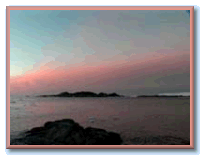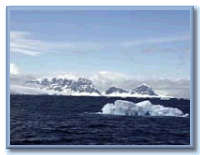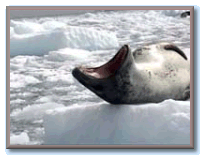|
From: Dr. Ralph Bovard, Palmer Station Over the past few months, Palmer's resident doctor, Dr. Ralph Bovard, has corresponded via e-mail with students from the 5th grade class taught by one of Ralph's old high school friends, Scott Peterson, and another 5th grade class taught by Scott's wife, Janet. These letters provide a fascinating portait both of a place and a person, and also shows what interests young people about Antarctica and the unusual group of people who live and work there. Mason City, Iowa, is the River City of Meredith Wilson's "Music Man" and Ralph's hometown. Ralph's folks still live there. His family lives up at Clear Lake in the summers which is where Buddy Holly played his last gig with the Big Bopper and Richie Valens before they were killed in a plane crash in Febrary 1959. Some of these letters served double duty going both to family and the 5th grade class. P.S. We really will try to find out why Ralph has the nom d'email, Dogear (or is it Doggear?) *** Date: Thu, 17 Oct 1996 00:16:33 -0500 Subject: Pen pal Dog Ear Yo Mr. Petersen and the fifth grade class, Reading you loud and clear. Amazing technology isn't it. I am not sure if my parents forwarded this epistle to you or not so I will send it anyway. Did you get my letter which I mailed last month? Our next ship arrives on Oct 30th heading back to S. America. Thanks for rubbing in the bit about the wonderful Fall weather. I do miss it. Iowa has its own special beauty that fortunately not a lot of people appreciate... so it stays relatively unpopulated. I will be sending a poster on the next ship and am going to send a videotape of a tv show called Newton's Apple that was done in 1992 about Palmer Station. It is about 20 min long. I will send it to my parents and have them share (loan) it with (to) you. Have a Tom Turkey for me at the feast. Our cooks are actually amazing... too good in fact. I may look like an elephant seal by the time I am ready to leave. Hope all is well. I can try to send a short letter every week or two, or whatever seems good. Pretty busy actually but this will be fun. Cheers, Dog Ear Bovard *** Greetings all, Anyway, I am going to try to do a composite letter and have been meaning to sit down and "start at the beginning" to tell you about what goes on down here.
Sometimes I suddenly realize, with a start, that I am way down here on the bottom of the Earth, a long ways from anywhere. You step outside and there is nothing but darkness in every direction. The wind is howling in from the northwest at 20-60 knots not infrequently whipping the wind in spindrifts off the glacier. Occassionally there are great rumbles as huge slabs of ice break away and fall into the sea i.e. the birth of an ice berg and siblings. The sea swells and surges in the harbour and inlet beside the little peninsula on which the station is built. Sometimes, like today, it is full of "land ice", broken shards of glacier, smaller than icebergs, called "bergy bits". The water temperature has been steady at -1.8 C and usually doesn't freeze until about -4 C. "Sea ice", by contrast, has a number of descriptive names, almost like snow does for the eskimos. I think I have sent you a copy. (And see the LFA 2 Teacher's Guide for more on the 70 plus names ice can have! Ed. note.) Ice can be new, old, fast, open pack, close pack, nilas (thin crust floating on surface), rind (brittle shiny crust formed from...), grease (later stage of freezing when spicules and plates coagulate to form thick soupy layer), frazil (fine spicules in suspension), slush, shuga (spongy white ice lumps)... to be "old" the ice has to be more than two years old and up to 3 meters or more thick. The air temp. lately has been about 1 C, and the coldest since we arrived was -8 C. The record low here has only been -15 F (~- 26 C). Warmer than Iowa or Minnesota that is for sure. We are coming into the spring now, so the snow is turning to rain and much of the ground snow is melting. We played softball up on the glacier last Sunday until the ball got knocked out of bounds into the crevass field. Then we had to go down the glacier (it is a mile up to the top and 640 vertical feet elevation gain from sea level) to get ropes and safety harnesses to retrieve it. We need to order more softballs! We have a pretty good gym with an electronic exercise bike, a rowing machine, a nordic trak, punching body bag, lots weights, leg press, lat machine, etc. There is also a large recreation room in which is located a humongous 50 some inch tv video system and nearly as many videos as at Blockbuster. We also have a regulation pooltable so I may be able to make up for not having had a sufficiently misspent youth. "Trouble in River City, with a capital T and that rhymes with p and stands for pool. Just call me Antarctica Fats, please, when I come back."
Also, for exercise we are able to perambulate, walk, run, snowshoe, ski up the glacier to the east of the station. It is 1 mile to the top and a 640 foot elevation gain. About 45 min round trip. Beautiful views of the surrounding seas and from there we can see the mainland of the Antarctic Peninsula some 15 miles away across the straits. We are actually on a island, Anvers Island which is about 60 kms long and 30 kms wide... it would be like skiing the Birke to go end to end. However, there is a 5,000 ft. peak called Mt. Williams several miles from us, and another peak that goes almost 10,000 ft at the other end of the island. Quite a view on a clear day. The weather has been a hodge podge. Occassional bright sunshine, but mostly blowing snow with gusts up to 60 knots as I mentioned earlier. It is very invigorating! My metabolism is getting revved up after the two years of the heat absorbing endothermic existence in Tucson. I miss my friends there, but the 100-118 temps were sapping. I am really rambling, aren't I? So much has happened in the last 2 months that I think I have had some sensory overload. Plus getting settled into a new locale with new friends, and very different job requirements. I think that I mentioned that in addition to being the base physician for the 25-45 station personnel (which obviously should not keep one doc "busy"), the MD here does the following tasks: * medical supplies and inventory, reordering, stocking, etc *x-ray technition; take and develop the films and mix developing solutions. We had to do this in Papua New Guinea and I also did it some at Snowmass so this is no major problem. *lab technician; running the 3 analyzer machines, including calibration for everything from hemoglobin to cholesterols to amylase, total bilirubin, cardiac enzymes including ck-mb fractions. Also have to be able to do gram stains and wbc counts the latter of which I am working on. Gotta appropriate some 3% glaciated acetic acid from the lab folks for the dilutant. Makes you appreciate all the behind the scenes folks back home. *hot tub chlorination and bicarbonate tester and adder. *station water sanitation tester using coliform analysis kits for water purity. We have a neat set-up, and have had very little problem producing clean H2O. Also do general food sanitation review with the cooks for disinfection and clean up. *once a day do one of the four meteorological reports to the British base Rothera, 200 miles away, via radio, who then forwards the reports via satellite to NY and London. We have to encode all the minutiae of cloud types, heights, wind, water temps, dew points, rel humidity, wind direction & speed, max. gusts, barometric pressures, etc. you get the idea. I am reading a cloud book this week and it is actually quite interesting. All about castellatus, pileus, cloud anvils and streets, and such. Our main weather guy, John Booth, is actually an astronomer/ equipment technician who is also the Antarctic table tennis champ (never been beaten on the continent -- S. Pole, McMurdo, or here) and also my main pool adversary. *store manager: This is the most time consuming thing I do. Manage all the inventory, stocking, purchasing, receipts, sales, for the station store. We sell souvenirs such as t-shirts, decals, hats, medallions, plus all sorts of personal gear, toiletries, etc, PLUS I run the liquor store in toto. About 40% of total annual sales of 50-60,000 dollars is souvenirs (mostly to the tourists who come through on about 10 ships between Dec. and Feb.) As I mentioned they had recently started using a computer till instead of the old hand rung "ka-ching" register, and it has been chaotic at times. Lately I have been working on deciphering barcodes (yes, I have one of those too), to produce wall charts with Microsoft Excel 5.0 for item price lists. Whoever thought I would one day be talking about inventory analysis, vendor discounts, and item reorder flags. I carry about $1,000-1,700 in the till and we often do $3,000/day sales when the ship Polar Duke comes in. *Tied into all this is my role as postmaster handling all the stamps, mailing, and cachet stamping of packages. We have about $2,100 in stamps at present. Just finished the count for monthly report. The doc also serves as the philatelist... careful, you are thinking of some different words... for all the avid stamp/Antarctica cancellation ink stamp logos persons all over the world. Most seem to be Western European, French, English, Spanish, etc but we get letters from all over. I rubberstamped about 30 last night. And of course there are the often exotic stamps on the cover letters in which the return letters arrive. Any of you philatelists? *Also help with safety and hazardous work evaluations and am the medical support for all the SAR (search and rescue) teams. OSAR for ocean and GSAR for glacier. *Do weekly air sampling collections for 3 scientific groups: NOAA (Natl Oceanic and Atmospheric Admin), Scripps Oceanographic Inst., and OGI (Oregon Grad Instit.). Takes about 4 hours/wk. *Participate in weekly facilities cleaning @ Saturday and do kitchen clean up one night per week. Also serve on night watch every couple of months. *Serve as tour guide for visiting VIPs none of whom I have seen yet. And I came here to have some peace and quiet and write the Great American Novel? Hmmmm. There are 37 people on station now. Ten new NSF (National Science Foundation) scientists arrived on the Polar Duke vessel last weekend. Of these people 21 of us are ASA employees as opposed to NSF science funded grantees. We exist and are here solely to "support" and make possible the carrying on of the NSF research. The ASA people are administrative, cooks, carpenter, electrician, logistics, marine/boat coordinator, heavy equipment operators, mechanics and engineers to keep power plant running, and of course several computer (comms) specialists. Learning how to get around DOS and use Word Perfect as it interfaces with the new Word for Windows etc has been almost the most trying thing for me. What else to tell you? I ran my own cholesterol on the analyzer. 168 not too bad but my highest, although it was not fasting and was right after breakfast. I am listening to the sound track from "Out of Africa". My Sony Walkman has gone on the fritz and I had to jury rig an old Sanyo cassette I found in a drawer with an oversized 11.6 volt transformer down to 3v. Wish I had brought more CDs. I did bring small compact CD player. I had every intention of reading and writing etc. more but when you are working in the store or doing inventory it is nice to have some tunes. There are no radio stations to get and I wasn't even able to pick up anything on the little shortwave radio I brought along. It is 9:20 pm here and the winds have died down. I hiked up along the inlet on the east side of our inlet after dinner. There are 3 Weddell seals which have pupped and the 3 young ones, although being only 7-10 days old are already as big as a young labrador, probably 30-40 lbs. already. I have learned that not every seal is the same! They belong to the order pinniped. There are two main families below that, the otariidae or "eared seals" which include the sea lions, fur seals, and walruses, and the phocidae or "true seals" which include the Crabeater, Weddell, and the Leopard seal.
This last one, hydrurga leptonyx, has quite a reputation as a fearsome beast which has attacked man and with the huge jaws and canines and being 10-12 foot long it has the potential to do some major damage. Shakleton's men were attacked by and killed several. Our divers are very leery of them. I don't know much about the penguins, yet. OUr ornithological researchers are here in force now, though, so I will learn more soon. We have an old penguin skeleton which we use for calibrating the x-ray machine; it is similar in density to finger bones. Oh, a US television crew (?Public TV) is going to be doing a special here in Jan-Feb. Should be on US telly sometime then... live, I guess. More when I know more. The ship which came in last weekend was the first since I arrived and it won't be back to Chile until late Oct. to drop off mail. It then returns here on about Nov. 11 to take a few folks off and bring a few replacements. Next one in December. Time is going quickly... as always. Did I mention that I ...am growing a beard? Like father...like son. 'Cept I don't look nearly so Olympian, or even like Sean Connery like my pater. Our exact location in case you are a GPS person is 64 degrees 46 min south and 64 degrees and 04min west. There ya have it. Hope this fills you in on what I have been up to ...or more correctly, up with what I have been? Huh? Speaking of confusion, how is the presidential debate going? May get my absentee ballot in time. Hope you are well and miss you all very much. Sorry, I am not around more, I just get these crazy urges to see odd places. That doesn't mean that I don't miss you dearly. Blue skies and black coffee, |
||||||||
| Back to Field Journals Menu | Back to Dr. Ralph Bovard's Journals | Pen Pal Dog Ear | ||||||
![]()


